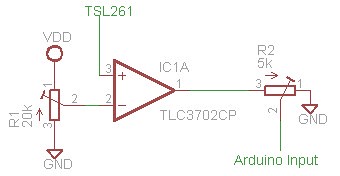Hi, If you are looking for a nice Stalker project to get you started with some hardware and code… take a look here:
Really Nice Project…
Thank you very much
Albert
Nice job at the documentation and description. It should be useful for many users. I have used both the TAOS TSL261 and TAOS TSL267 for monitoring my meter and the TSL261 will be the better choice for most users. the TSL267 is about 10 times more sensitive which requires blocking all background light. Another thing to note is that the Stalker inputs accept a max of 3.3 vdc so connecting the TSL261 to 5vdc might cause problems with the Stalker. It might be better to power the sensor from a pin or use a voltage divider. The TAOS sensors require a minimum of 2.7 volts so the 3.3 vdc from the pins should be okay.
The 100ms delay for the watt indicator light should be okay for most users but will limit measurement to less that 10 watts per second or 36 kwh. I would drop the delay back to 50ms to increase measurement range.
I have rewritten my sketch using some of the code from your example and adding a few other changes. I will post it on the Stalker thread on the Arduino forum.
Thanks CRS2010,
I will look at making an update based on your advice 
Are you taking your 3.3V off the I2C header? My 3.3V main header is not working.
All good stuff - cheers.
cambo,
Here is a post I did on the Arduino forum regarding signal processing:
I have built a simple shield to clean up the signal from the IR sensor. It uses a TLC3702CP push-pull comparator to give a nice clean 0 - 5 vdc square wave signal. The comparator eliminates any problems due to background light changes. I set the trigger at 3 volts so anything below 3 volts gives a 0 volt signal and anything above results in a 5 volt signal. The comparator is not entirely neccessary but makes the system more robust. I am new to the Eagle program but tried to put together a schematic:

Edit: If you use 3.3 volts for VDD you do not need the R2 voltage divider.
I have been using a Dane Elec SD card with the script without problems but when I started making changes to the script, I started getting errors. The Fat16 author does not recommend Dane Elec so I tried a Kingston card and the script started working properly. See the Readme.txt file in the Fat16 documentation for more info.
I am working on a sketch that uses the Fat16 and messenger libraries to write data from the serial port to the SD card. I will be posting it on the Arduino forum so I do not hijack this thread any further.
Thanks again CRS2010, I havn’t tried the hardware mod yet but have updated the project page with your suggestions. Hopefully I will find time to have a go with the circuit you describe soon - much appreciated.